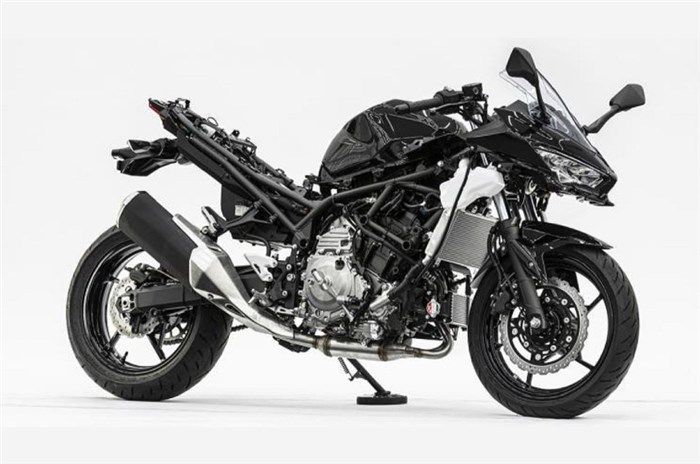After unveiling the EV Endeavor in 2019, Kawasaki is back at it, announcing a new Hybrid Motorcycle that will be the first of a new wave of hybrid and electric motorcycles expected to launch by 2025. Several pieces of new technology have been included and adapted in order to increase performance and efficiency, and Kawasaki is also taking technology from electric cars and adapting them for motorcycle use. This particular Hybrid Motorcycle is also derived from the template of several Ninja models.
Details may be limited at this point, but read on to find out more about Kawasaki's new Hybrid Motorcycle and what features it offers.
First Of A New Wave Of Kawasaki Bikes
The Kawasaki Hybrid motorcycle is the first of a new wave. Based on various predecessors such as the Ninja 250 and Ninja 400, this new model has a hybrid prototype available for the show. It has been confirmed that this new motorcycle will showcase both a headlight design and a small parallel-twin engine reminiscent of its Ninja predecessors.
The engine has also been downsized in order to make room for both a water-cooled electric motor beneath the main radiator and a 48-volt battery. The clutch will be automatic and the transmission will be semi-automatic, and the electric motor is planned to double as a generator. The motorcycle can also run solely on either its petrol engine or its electric motor, allowing the prototype to qualify for use in zero-emission zones.
Kawasaki Is Planning To Go 'More' Green
The Hybrid Motorcycle is part of a larger initiative Kawasaki is implementing that focuses on being more eco-friendly. Kawasaki wanted to make 10 hybrid or fully electric motorcycles available for sale by 2025 in order to fuel its greener endeavors, and further plans call for a fully electric lineup by 2035. The Hybrid Motorcycle is Kawasaki's first planned hybrid motorcycle, and the bodywork on the prototype was somewhat removed in order to demonstrate its workings and show off its hybrid powertrain, which has both an electric motor and a parallel-twin engine.
Regenerative braking will also be added to charge the battery and conserve wear and tear on brake pads. The GPS on the motorcycle can switch the powertrain to electric once the bike enters the city in order to curb emissions. Hybrid powertrains have not had much success when applied to motorcycles, but Kawasaki aims to change that with the arrival of the Hybrid Motorcycle. The fully-ready production version of the Hybrid Motorcycle is scheduled to arrive in early 2022, with more fully electric motorcycles to follow.
Is The Timing Of The Kawasaki Hybrid Prototype Right?
Several hybrid motorcycles have been in the planning stages in earlier years, but none made it to this point. Even Kawasaki themselves had previously attempted to try its hand at a potential EV/hybrid concept. In 2019, they adapted a hybrid motorcycle from the template of the Ninja 300, known as the Endeavor. This new Hybrid Motorcycle could either be viewed as the next step for the Endeavor, or it could be a restart and a separate project entirely. However, while hybrid cars have taken off in popularity, hybrid motorcycles have not.
Thanks to motorcycles' smaller engines, it's hard to fit an electric motor inside without also increasing the weight. Further, increasing the weight compromises the benefits of fuel economy and performance, negating the overall benefits and making the bike highly impractical. Other companies, such as Honda, have attempted to manufacture their own version of a hybrid motorcycle, but have also run into the same impediments and roadblocks as Kawasaki has.
How The Kawasaki Hybrid Works
The specific detailed workings of this motorcycle differ from the standard motorcycle. As mentioned before, the Hybrid Motorcycle can be electrically powered when in the city. Conversely, it can also run on gasoline when out in the suburbs or country. By operating both in tandem and alternating when necessary, overall levels of performance are increased. Regenerative braking helps recharge the 48-volt battery under the seat.
Its parallel-twin engine is also bolted to a new, purpose-made tubular steel frame, complete with a huge electric motor placed just above the transmission. The automated gearshift is also advanced technology that showcases both an automated clutch and a servo-operated shifter that will let the rider make changes at the push of a button. This automated gearshift, when applied to the hybrid, also makes the transition between gas, electric, and hybrid modes more seamless for the rider.
Sources: autocarindia.com, gaadiwaadi.com, cycleworld.com, autoblog.com,


--New-Atlas.jpg)
--Motorcycle-News.jpg)
--Motorcycle-News.jpg)
--Nikkei-Asia.jpg)